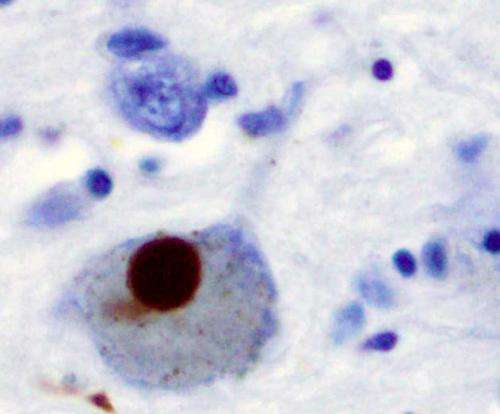Gene therapy prevents Parkinson's disease in animal model

Gene therapy to reduce production of a brain protein successfully prevented development of Parkinson's disease in an animal study, according to researchers at the University of Pittsburgh School of Medicine. The findings, published online today in the Journal of Clinical Investigation, could lead to new understanding of how genetic and environmental factors converge to cause the disease, and the development of effective treatments to prevent disease progression.
Scientists have observed dysfunction of mitochondria, which make energy for cells, in Parkinson's disease, as well as Lewy bodies, which are characteristic clumps of the cellular protein α-synuclein within neurons, said principal investigator Edward A. Burton, M.D., D.Phil., associate professor of neurology, Pitt School of Medicine.
"Until now, these have been pursued largely as separate lines of research in Parkinson's disease," Dr. Burton said. "Our data show that mitochondria and α-synuclein can interact in a damaging way in vulnerable cells, and that targeting α-synuclein might be an effective strategy for treatment."
The team wanted to see what would happen if they knocked out the production of α-synuclein in the brain's substantia nigra, home to the dopamine-producing cells that are lost as Parkinson's disease progresses. To do so, they used a harmless virus called AAV2 engineered to transport into the neuron a small piece of genetic code that blocks production of α-synuclein. They delivered the gene therapy to the brains of rats and then exposed the animals to the pesticide rotenone, which inhibits mitochondrial function.
"Our previous work established that rotenone exposure in rats reproduces many features of Parkinson's disease that we see in humans, including movement problems, Lewy bodies, loss of dopamine neurons and mitochondrial dysfunction," explained co-investigator J. Timothy Greenamyre, M.D., Ph.D., Love Family Professor of Neurology, and director of the Pittsburgh Institute for Neurodegenerative Diseases at Pitt. "We found that our gene therapy prevented those symptoms from appearing, which is very exciting."
Each side of the brain controls the opposite side of the body. The left sides of rats that received gene therapy to the right side of the brain did not become stiff and slow, while their right sides did. The researchers determined that dopamine neurons on the treated side of the brain were protected from rotenone, accounting for the substantial improvement in movement symptoms. In contrast, untreated animals and animals that received a control virus that does not reduce α-synuclein production, developed progressive Parkinsonism and loss of dopamine neurons.
In next steps, the researchers plan to unravel the molecular pathways that enable α-synuclein levels to influence mitochondrial function and develop drugs that can target the underlying mechanisms.
"The viral vector AAV2 has been used safely in Parkinson's disease patients in clinical trials, so the gene therapy approach might be feasible," Dr. Burton said. "We think targeting α-synuclein has great potential to protect the brain from neurodegeneration in Parkinson's disease."
"We hope to be able to translate this general approach of reducing α-synuclein into human clinical trials soon," Dr. Greenamyre added.

















